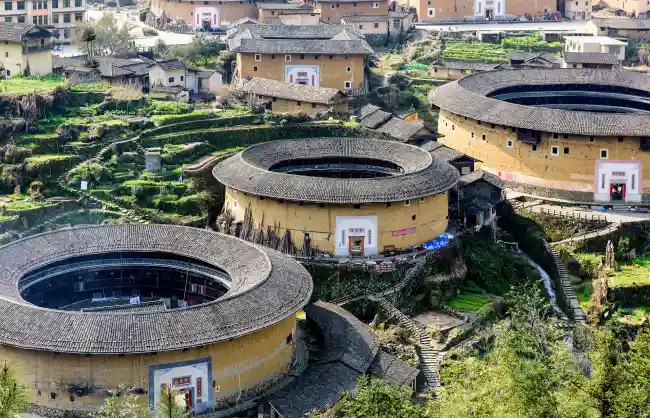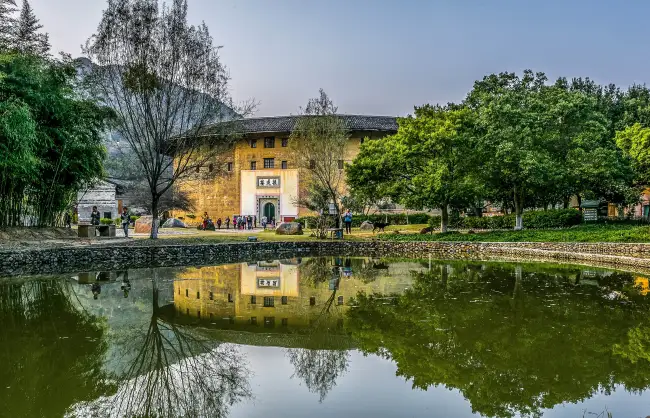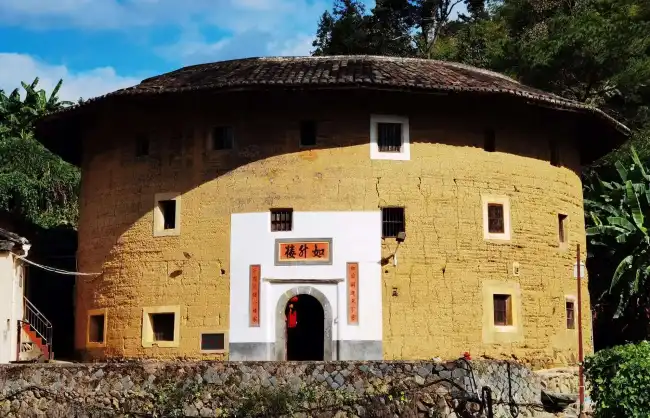Fujian tulou is not only unique in traditional Chinese ancient residential buildings, but also an unparalleled representative of residential buildings in the history of world architecture. Hongkeng Tulou Cluster, a masterpiece of Fujian Tulou, is famous for its long history, unique style, large scale, exquisite structure and complete functions, and is known as “a shining pearl of Oriental civilization”.
There are more than 23,000 tulou of 30 kinds in Fujian Province. In July 2008, Fujian tulou, including the Hongkeng Tulou Cluster, were inscribed on the World Heritage List.
Hongkeng Tulou Cluster Facts
Location: Hongkeng Village, southeast of Yongding County, Fujian Province, China
Ticket Price: 90 yuan per person
Opening Time: Open from 8:30-20:30 during winter, visitors are not allowed to enter at 20:30; Open from 8:00-21:00 during summer, with visitor access to Hongkeng Tulou Cluster closed at 21:00.
Transportation: Take the bullet train to Fuding Station, then take the bus to Hongkeng Tulou Cluster. Or take a bus from Longyan Bus Station.
Suitable for: People who are interested in the Chinese folk culture of Yongding Hongkeng Tulou Cluster and outdoor lovers.

Architecture Features of Hongkeng Tulou Cluster
Fujin tulou is built with earth walls. It has various shapes, such as round and square. Entering the interior of the tulou, you can see layers of corridors spiral upward, in order to take into account good ventilation and lighting conditions, there will be a huge courtyard in the middle. Among the Hongkeng Tulou Cluster, you can visit the most magnificent “Tulou Prince” – Zhencheng Building, the most classic Fuyu Building, just like the palatial architecture of the Potala Palace in Tibet – Kuiju Building, and the smallest round building – such as Rusheng.
What to See and Do in Hongkeng Tulou Cluster
Zhencheng Building
This tulou was built in 1912 and took five years to complete. The word “Zhencheng” expresses the builder’s respect and remembrance of his ancestor Lin, meaning that no matter standing in the position of the country or the family, we must abide by the law, in order to cultivate people with both virtue and talent.
The Zhencheng Building consists of an inner building and an outer building. The outer building is four storeys high, with 48 rooms on each floor, built according to the “Eight Trigrams” layout of the ‘Book of Changes’. The biggest architectural feature is that when the door is closed, it forms a courtyard without interference, and when the door is opened, the whole building is connected as a whole.
The inner building is divided into two floors, and there is a hall in the middle of the building in the imitation of Western style, which is not only a place for the wedding and funeral of the whole building, but also a hall for the clan to discuss and gather.

Kuiju Building
It is a square building of palatial structure in Hongkeng Tulou Cluster, built against the hill. From a distance, it has the momentum of the Potala Palace in Tibet, and from a height, this tulou is connected with the ridge behind it, like a tiger coming down the mountain.
The tulou has a thick exterior wall, only one window on the top floor, and only one door for people to enter and exit, which is extremely self-enclosed. Kuiju Building was built in 1834, and for more than a hundred years, many outstanding talents have gone from here to the outside world.
Fuyu Building
It is the first of the square tulou in Hongkeng Tulou Cluster and is also an outstanding representative of the mansion-type Hakka Tulou Clusters. According to the Lin clan, the owner’s father served as an official in the Qing Dynasty, so he was allowed to build such an ornate residence. The whole building is axisymmetric and magnificent, covering an area of more than 7,000 square meters. At its peak, there were 27 households with more than 200 people.
Rusheng Building
It has been the smallest circular tower ever discovered in Hongkeng Tulou Cluster. The whole tulou is three stories high, a single circle building with an inner corridor, which can accommodate six families. The appearance of this fujian tulou is very similar to the Hakka rice measuring tool “Mi Sheng” made of bamboo tubes, hence the name Rusheng.

Best Time to Visit Hongkeng Tulou Cluster
Fujian Tulou can be visited year-round, but the best time to visit is during the months of March to May and September to November. During these months, the weather is mild and comfortable, with fewer crowds and a lower chance of rain. The temperature during this time ranges from 10°C to 25°C, making it ideal for outdoor activities.
Attractions Nearby Hongkeng Tulou Cluster
Taxia Village: This is a Hakka village in a valley surrounded by green mountains with beautiful scenery. The village stands with different styles of fujian tulou complex, ranging in time from dozens to hundreds of years.
Mount Wuyi: It is listed by UNESCO as a World Cultural and Natural Heritage Site. Here you can see the typical Danxia landscape, thousands of species of flora and fauna. You can reach Mount Wuyi by public bus and bullet train from Hongkeng Tulou Cluster.
In addition to these two magnificent attractions, if you are interested in other Fujian tulou and spots, we can customize fujian tours with tulou and sightseeing trips for you.









